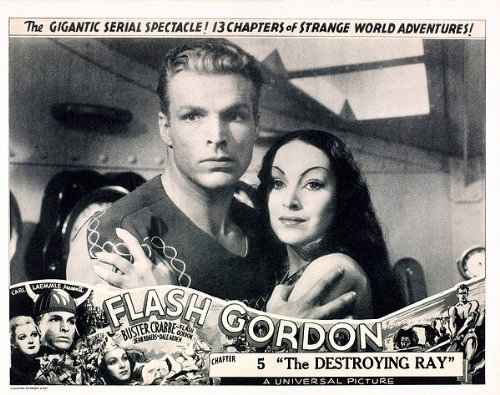Before laser swords and the galaxy far, far away, the very name “Flash Gordon” ignited the imaginations of adventure-loving audiences. In 1936, Universal Pictures brought Alex Raymond’s iconic comic strip hero to the big screen in the first of three Buster Crabbe-led serials, simply titled “Flash Gordon”. While undeniably a product of its time, this initial chapter showcases a surprising level of ambition and spectacle that solidified Flash Gordon as a pop culture icon.

Disaster looms as the rogue planet Mongo hurtles on a collision course with Earth. Athlete-turned-adventurer Flash Gordon, his companion Dale Arden, and the brilliant but eccentric Dr. Zarkov rocket to Mongo in a desperate bid to avert catastrophe. On this strange and wondrous planet, they encounter the merciless Emperor Ming, who lusts after Dale and forces Flash into deadly gladiatorial games. Princess Aura, Ming’s daughter, offers a glimmer of hope amidst a world of ray guns, Hawkmen, and perilous encounters in this classic space opera. The serial format keeps the action relentless, as each chapter ends on a suspenseful cliffhanger.
Considering its 1930s origins, “Flash Gordon” boasts a surprising degree of visual flair. While effects may appear primitive by modern standards, it’s important to appreciate the imagination on display. Ming’s art deco palace, with its gleaming towers and stark geometry, is a striking example of early sci-fi design. The winged Hawkmen costumes, while clearly impractical, possess a unique, pulpy charm. Even the stylized rocketships, defying any sense of real-world physics, ignite a sense of childlike wonder. Naturally, the effects haven’t aged flawlessly; explosions are quaint, and some set pieces reveal their budgetary limitations. However, “Flash Gordon” earns points for ambition and remains a visual feast for fans of retro sci-fi aesthetics.
Buster Crabbe fully embodies the all-American hero archetype as Flash Gordon. His athletic background shines through in the numerous action scenes, and while his acting may not be particularly nuanced, he projects a sense of unwavering determination and classic leading-man charisma.
Charles Middleton’s performance as the megalomaniacal Ming the Merciless is the stuff of legend. His exaggerated expressions, sinister pronouncements, and over-the-top villainy have become synonymous with space opera tyrants. Middleton relishes every moment as the cruel emperor, creating a truly memorable antagonist.
Dale Arden, played by Jean Rogers, unfortunately falls into the classic damsel-in-distress trope. Her primary function is to be imperiled and rescued by Flash, offering limited character depth beyond that. Dr. Zarkov (Frank Shannon) delivers the necessary scientific exposition with a touch of mad scientist charm, rounding out the core trio of heroes.
Princess Aura (Priscilla Lawson) provides an intriguing twist as Ming’s rebellious daughter. She adds a layer of complexity to the narrative and serves as a potential ally for Flash amidst Mongo’s dangers.
“Flash Gordon” thrives on the classic serial format, delivering thrills and spills in bite-sized chunks. Each chapter concludes with a tantalizing cliffhanger, leaving Flash and his companions in seemingly inescapable peril. While some of these predicaments border on absurdly cheesy by today’s standards (think shark-infested pits or runaway rockets), they were likely played with utter seriousness at the time, adding to their retro charm.
The serial’s pacing is undeniably brisk. The episodic nature rarely allows for a moment’s rest, propelling the plot forward with relentless action sequences and exotic encounters. However, this also leaves limited room for character development or deeper thematic exploration. At times, the reliance on repetitive tropes (kidnappings, daring escapes, last-minute rescues) might make the overall experience feel slightly formulaic.
The camp factor in “Flash Gordon” is both undeniable and likely a key ingredient in its enduring appeal. Whether it’s the over-the-top acting, simplistic dialogue, or the outlandish gadgets, there’s a certain tongue-in-cheek quality that permeates the serial. While unintentional in the 1930s, modern audiences can revel in the campy spectacle, making “Flash Gordon” as much a delightful comedy as it is a sci-fi adventure.
“Flash Gordon” played a pivotal role in solidifying the tropes of space opera within popular culture. Its blend of exotic worlds, daring heroes, beautiful princesses, and nefarious villains set the blueprint for countless sci-fi adventures to follow. The visual language of ray guns, rocket ships, and tyrannical emperors has its roots firmly planted in serials like this one. George Lucas famously cited “Flash Gordon” as a direct inspiration for his “Star Wars” saga, a testament to the serial’s enduring impact.
Today, “Flash Gordon” holds value on multiple levels. Purely as entertainment, its campy charm, thrilling action, and nostalgic feel are undeniable fun. Yet, it’s also a fascinating historical time capsule, offering a glimpse into the filmmaking techniques and audience sensibilities of its era.
Despite its dated elements, the first “Flash Gordon” serial remains a landmark achievement in early science fiction cinema. It boasts imaginative visuals, iconic performances, and a wholehearted dedication to pure, unadulterated adventure. While it may not satisfy viewers seeking complex narratives or modern special effects, I wholeheartedly recommend it to anyone with a love for classic cinema, campy sci-fi, or the origins of pop culture’s fascination with space heroes.
